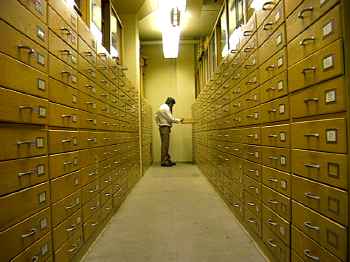 Rodney Watkins in the Milwaukee Public Museum collections.
Rodney Watkins in the Milwaukee Public Museum collections.
Museum collections of fossils and rocks are preserved as the objective, physical record on which dioramas and research conclusions are based. Permanent storage and maintenance of these collections is an important part of the scientific process. Geologists use these collections to compare the biodiversity of Silurian reefs in Wisconsin and Illinois to that of reefs in other areas and geologic time periods Collections are housed in extensive banks of drawers within a special storage room. The collections are organized along the aisles according to their geologic age and their geographic area of origin. Drawers along this aisle represent about one third of the Silurian collections in the Milwaukee Public Museum Specimens within drawers represent material from a specific collecting locality, in this case the Silurian reef at Quarry Lake park, Racine, Wisconsin. Within a drawer, the specimens are sorted according to taxonomic group. This drawer contains several species of brachiopods. Individual fossils are placed in small trays that include a label giving species name and locality data. All specimens and labels are marked with a number that is unique to their collection locality. Data about collecting localities and their content of fossil species are maintained on an electronic database. Shown here are data for geologic age and geographic location of reef collections from Quarry Lake Park, Racine, Wisconsin